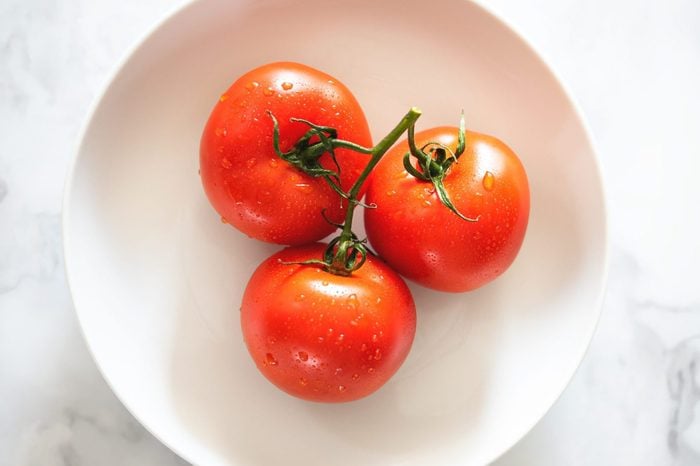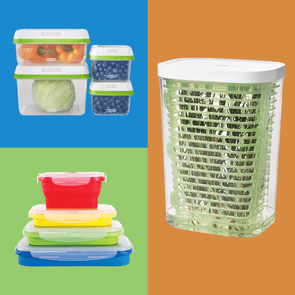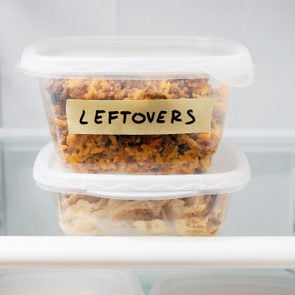Confirmed: This Is Where to Store Tomatoes for Peak Freshness and Flavor
Updated: Apr. 30, 2023

We're settling the debate on how to store tomatoes so they're perfectly ripe, red and flavorful
While we’d love to be able to stop by the grocery store on a daily basis, picking up ripe, fresh produce to eat that night, we don’t always have that luxury. Usually, we’re buying fruits and vegetables days ahead of time. In the case of heartier produce with straightforward methods for fruit and vegetable storage, that usually isn’t a problem—we know how to store food in the fridge. But with foods that are fickle when it comes to freshness, it’s a little trickier. That’s why it pays to know how to store tomatoes the right way.
Indeed, how to store tomatoes isn’t just a piece of food facts trivia to break out at parties. If tomatoes aren’t eaten at the peak of freshness, this vegetable (or is tomato a fruit?) can go from sweet and juicy to mealy and flavorless in a flash, regardless of your fridge organization. Here, we’re breaking down the facts on where and how to store tomatoes depending on their ripeness and how you plan to use them.
Get Reader’s Digest’s Read Up newsletter for more food, humor, cleaning, travel, tech and fun facts all week long.
Where should you store fresh tomatoes?
For optimal quality and flavor, keep fresh tomatoes on the counter or in the pantry, according to the U.S. Department of Health and Human Services. Especially if you buy unripe tomatoes, you want to keep them at room temp until they reach peak ripeness and you’re ready to consume them. Once they are ripe, you may want to consider moving them to the fridge, depending on when you plan to eat them.
How to store tomatoes that are unripe
Unripe tomatoes are hard and flavorless with an unappetizing texture. To ripen them, you’ll need to store them on the counter or in the pantry at room temperature (55 degrees or above) until they have a rich red color. (Whether ketchup needs to be refrigerated, though, is a different story.)
This is the point in a tomato’s life cycle—the still-unripe stage—when it should definitely not be kept in the refrigerator. According to the Florida Tomato Committee, the enzyme that gives tomatoes flavor stops being produced when the temperature of the tomato drops below 55 degrees. And this “off” switch is permanent.
What’s more, cold temperatures will degrade any flavor that the tomato already has and cause the water inside the tomato to expand. You can’t see the results of this expansion, but it will create a mealy texture when you bite into it.
There is some debate about how to store tomatoes physically, whether stem side up or stem side down. The Florida Tomato Committee recommends keeping them stem side up. The area around the stem—the “shoulders”—is the softest part of the tomato, so if you leave it resting on this section, the tomato will end up bruised. On the other end are folks who insist that storing tomatoes stem side down keeps them from drying out while they ripen because moisture escapes through the spot where the stem has been cut off. We say, you be the judge.
No matter which side you lay your tomatoes on, take note of their surroundings. If you have other produce on your counter, be aware of the fruits and veggies not to store together. Place them next to bananas, for instance, and you could accelerate the ripening process.
How to store tomatoes that are ripe
At this point, you might think that the answer to “Should tomatoes be refrigerated?” is always no. But that’s not the case.
Sure, tomatoes taste best when they are allowed to ripen at room temperature and then are kept at room temperature until you eat them. The U.S. Department of Health and Human Services says that you can store tomatoes at room temperature until ripe and then for seven days more—no vinegar wash needed.
That said, if your tomatoes are fully ripe, you’re not serving that caprese salad for another few days and you’re worried about them going bad (which is a definite possibility if you live somewhere warm or without air conditioning), you can put them in the refrigerator. This will halt the ripening process and keep them fresh until you’re ready to enjoy them.
Since the cold temperature will still degrade the flavor a bit, it’s smart to let them come back to room temperature before serving. But keep in mind that unlike how eggs need to be refrigerated, whether you pop your tomatoes in the fridge has nothing to do with food safety.
How to store tomatoes that are sliced
As with all fruits and vegetables, once you’ve sliced a tomato you want to eat it ASAP. But if you do need to store sliced or cut tomatoes, wrap them tightly in plastic wrap to prevent too much moisture loss. They’ll last in the refrigerator for up to a day or two.
Can you freeze tomatoes?
Let’s recap: Should fresh tomatoes be stored on the counter? Almost always. Should tomatoes be refrigerated? Not if you can help it, but it’s OK if they’re fully ripe. So, can you freeze tomatoes? You can, but it is going to change the texture when they are thawed.
Remember how the texture of refrigerated tomatoes is more mealy because the water inside the tomato has expanded slightly? When frozen, that water is going to expand as much as it can and then shrink down beyond its original state when thawed. In other words, fresh tomatoes will not be solid once thawed, so it’s best to only use them for cooking sauces or stews.
For optimal flavor and ease of use, the National Center for Home Food Preservation suggests coring and peeling the tomatoes first and then freezing them whole or in pieces. Frozen tomatoes will keep for up to two months, so if you need to store tomatoes for a month or more, this is your best bet.
Now that you’ve mastered how to store tomatoes, check out these tips on how to keep fruits and vegetables fresh longer and these surprising foods that need to be refrigerated.
Sources:
- U.S. Department of Health and Human Services: “FoodKeeper App”
- Florida Tomatoes: “Retail Handling Tips”
- National Center for Home Food Preservation: “Freezing Tomatoes”



